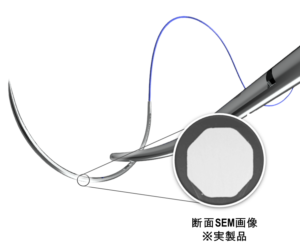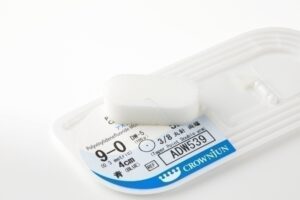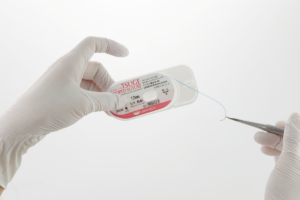Microsurgery is a term composed of “micro” (small) and “surgery,” referring to a type of surgery that requires the use of surgical microscopes.
To address the concern of not having a specific image in mind,
let me summarize its history and overview.
The pioneer of microscopic surgery was a Swedish otorhinolaryngologist
The world’s first surgery using a microscope was performed in 1921 by Swedish otolaryngologist Karl-Olof Nilén at Stockholm University.
(By the way, he was also a famous tennis player who competed in the Olympics.)
During this surgery, he used a monocular microscope, but the following year, his colleague, Gunnar Holmgren, also an otolaryngologist, developed a binocular microscope.
Since then, surgeries using microscopes have expanded beyond ear surgeries and are now performed in fields such as ophthalmology and neurosurgery. Currently, microsurgery is applied in various domains, including plastic surgery, reconstructive surgery, ophthalmology, gynecology, ear, nose, and throat surgery, neurosurgery, oral and maxillofacial surgery, pediatric surgery, and urology.
Advances in vascular anastomosis
The most significant advances in microsurgery are the procedure of vascular anastomosis and nerve repair, which allows tissue transfer from one part of the body to another and the reattachment of severed parts. It is said that before the term “microsurgery” was coined, vascular anastomosis was already being performed as early as 1896, long before the advent of surgical microscopes.
Advancement during the World War II
World War II led to significant progress in vascular surgery.
The establishment of antibiotics, improved infection control, and the development of micro sutures and instruments have improved the outcome of vascular surgery, enabling the successful anastomosis of vessels smaller than 3 mm. The first surgery using a microscope for vascular anastomosis took place in 1960, performed by vascular surgeon Jacobson at the University of Vermont, in which a 1.4mm blood vessel was anastomosed, and he used the term “microsurgery” for the first time.
Economic growth and microsurgery
In regions like our country that experienced rapid economic growth after the war, the number of accidents increased alongside industrial development, making microsurgery even more crucial.
Especially in the field of hand surgery,
Microsurgery became essential for the repair of severed parts, tissue transplantation to address defects and improvement of functionality.
The first successful reattachment of a completely severed finger occurred in 1965, performed by Professors Susumu Tamai and Shigeo Komatsu of Nara Medical University on a man who suffered an occupational accident resulting in the loss of his thumb.
Our company also contributed to the field by introducing the first microsurgery-specific suture with needles in 1974, during the era of rapid economic growth.
Treatment of Malignant Tumors (Cancer) and Microsurgery
Cancer is a common disease, with approximately 1 in 2 Japanese individuals being diagnosed with some form of cancer during their lifetime.
Although new treatment methods have been developed and in some cases, it can be cured without surgical treatment,
However, in some instances, surgery is required to remove malignant tumors, which results in significant tissue damage in the area where the tumor was located.
This is where microsurgery comes into play for reconstructive procedures.
The vascularized tissues from different parts of the body, transplanted using microsurgery, are commonly referred to as a “free skin valve” or “free flaps”. Free flap transplantation is a typical plastic surgery technique used for various defect and deformity reconstructions, as it allows for the transplantation of “living autologous tissues” with attached blood vessels from the skin, subcutaneous fat, muscle, bone, etc.
Lymphedema treatment by lymphatic vein anastomosis
Microsurgery required in conjunction with cancer treatment is not limited to the physical reconstruction of body parts.
Surgical removal of lymph nodes or radiotherapy can lead to lymphatic flow stagnation,
resulting in persistent swelling of the arms or legs that can significantly impact daily life.
One method to address this issue is Lymphaticovenular Anastomosis (LVA), which aims to improve the condition of lymphedema.
By connecting the congested lymphatic vessels to nearby veins, the blocked lymphatic fluid can be redirected and drained.
Lymphatic vessels are extremely delicate, with a diameter of only about 0.5mm,
and the procedure must be performed under a microscope using ultrafine needles with a diameter of 50 micrometers (0.05mm) to suture the tiny vessels together.
Microsurgery is a “concept”.
When trying to express “microsurgery” in a more Japanese context, it is indeed described as “microscopic surgery using a microscope.” However, while pondering if this term fully captures its essence,
Clara Wong Winyi, an orthopedic surgeon in Hong Kong, gave a wonderful summary.
“Understanding the general definition of microsurgery can be challenging.
because it encompasses the concepts of ‘wide,’ ‘deep,’ and ‘fine.’
‘Wide’ refers to the types of diseases and the visible world.
Microsurgery treats a wide variety of diseases, such as defects resulting from post-traumatic, post-infective, tumor excision, and congenital conditions. Additionally, the magnified world under the microscope opens up new possibilities for accurate diagnosis and precise treatment.
‘Deep’ implies not only replenishing missing parts but also conducting complex grafts involving bones, joints, and muscles, contributing to functional reconstructions. Improvements in medical technology, advanced microscopes, sophisticated instruments, and suture materials have resolved numerous technical challenges.
Consequently, more delicate surgeries have become achievable, leading to outstanding results, such as regaining functional and sensory capabilities and fostering psychological well-being by restoring fingers to excellent conditions.
Furthermore, ‘fine’ signifies the ability to perform finer repairs, resulting in enhanced aesthetic outcomes and reduced damage to the donor site. For instance, Professor Koshima introduced perforator flaps in microsurgery, which renders the surgery less invasive and can be more suitable for the recipient sites as they provide higher flexibility and choices for donor tissue.
Considering these aspects, microsurgery enables us to magnify, see more, do more, do better, and help more. Until we can invent a medication which can be ingested and reforms an absent part, microsurgery will remain a precious mainstay of treatment.”
(Full text here)
―What do you think?
In other words, microsurgery involves performing delicate surgeries in various fields to achieve tissue and functional repair with minimal damage.
Making microsurgery more accessible
Clara Wong Winyi also comments on microsurgery in the following way:
“When the microscope has to be prepared for a hand operation, people would instantly perceive that the operation is labor intensive, demands long hours and patience, and is a tiring and hard work.
With the advancement of technology and bioengineering medicine, many surgeons may put microsurgery at the bottom of their treatment options exhausting many other treatment alternatives despite more expensive costs and less effective results. However, this should not be the real world of microsurgery.”
Microsurgery is a challenging procedure that requires doctors who have accumulated extensive experience and acquired the necessary skills over a long period. However, with the development of surgical robots and other medical devices, the burden on doctors can be reduced, and microsurgery may become more accessible and widely available. As a result, the landscape of healthcare could undergo significant transformations.






